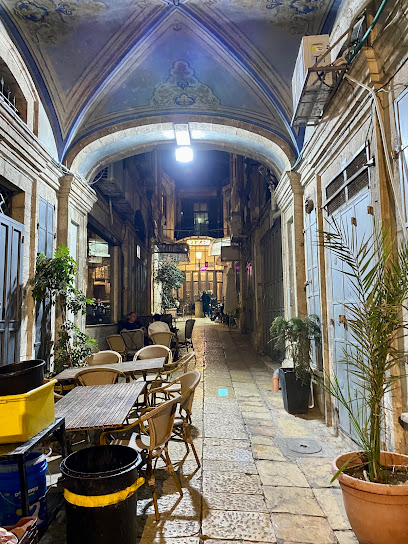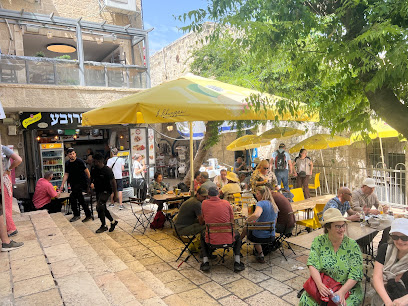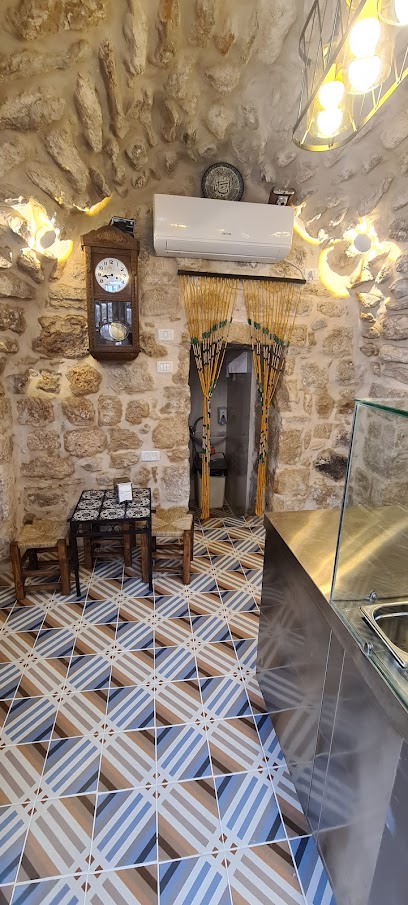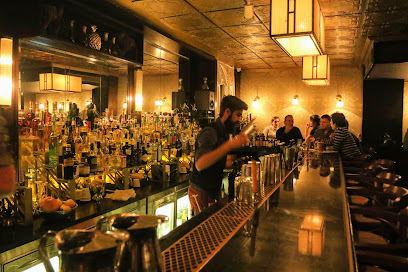
Exploring the Timeless Charm of Jerusalem's Old City
Discover the ancient heart of Jerusalem: the Old City, where history, culture, and spirituality converge in a captivating blend of sacred sites and vibrant markets.
Jerusalem's Old City is a mosaic of history, culture, and spirituality. Every stone and alleyway tells a story, making it one of the most unique destinations in the world. Enclosed by ancient walls, the Old City is divided into four quarters: Jewish, Christian, Muslim, and Armenian. Each quarter has its own distinct atmosphere and landmarks, offering a rich tapestry of experiences for visitors. Wander through the narrow, winding streets and discover sacred sites like the Western Wall, the Church of the Holy Sepulchre, and the Dome of the Rock. The spiritual significance of these places attracts pilgrims from all over the globe. As you explore, you'll encounter vibrant markets brimming with spices, textiles, and artisanal crafts. The lively bazaars are a feast for the senses, with vendors calling out to passersby and the aroma of freshly baked bread filling the air. Take a moment to savor the local cuisine, from delicious falafel and hummus to sweet pastries known as baklava. The Old City offers a variety of dining options, catering to different tastes and budgets. Whether you're a history buff, a spiritual seeker, or simply a curious traveler, the Old City of Jerusalem promises an unforgettable journey through time and tradition.
Local tips in Old City
- Wear comfortable shoes; the cobblestone streets can be uneven.
- Visit early in the morning or late afternoon to avoid crowds.
- Respect local customs and dress modestly, especially when visiting religious sites.
- Carry cash, as some vendors in the markets may not accept credit cards.
- Stay hydrated, particularly during the warmer months.
Exploring the Timeless Charm of Jerusalem's Old City
Jerusalem's Old City is a mosaic of history, culture, and spirituality. Every stone and alleyway tells a story, making it one of the most unique destinations in the world. Enclosed by ancient walls, the Old City is divided into four quarters: Jewish, Christian, Muslim, and Armenian. Each quarter has its own distinct atmosphere and landmarks, offering a rich tapestry of experiences for visitors. Wander through the narrow, winding streets and discover sacred sites like the Western Wall, the Church of the Holy Sepulchre, and the Dome of the Rock. The spiritual significance of these places attracts pilgrims from all over the globe. As you explore, you'll encounter vibrant markets brimming with spices, textiles, and artisanal crafts. The lively bazaars are a feast for the senses, with vendors calling out to passersby and the aroma of freshly baked bread filling the air. Take a moment to savor the local cuisine, from delicious falafel and hummus to sweet pastries known as baklava. The Old City offers a variety of dining options, catering to different tastes and budgets. Whether you're a history buff, a spiritual seeker, or simply a curious traveler, the Old City of Jerusalem promises an unforgettable journey through time and tradition.
Iconic landmarks you can’t miss
Western Wall
Discover the Western Wall, a sacred shrine in Jerusalem, where spirituality, history, and culture converge in a breathtaking experience.

Tower of David
Explore the Tower of David, a historic fortress in Jerusalem that offers captivating exhibits and stunning views of the Old City.

Damascus Gate
Experience the grandeur of the Damascus Gate, a historic entrance to Jerusalem's Old City, rich in culture and architectural beauty.

New Gate
Explore the historic New Gate in Jerusalem, a gateway to the Old City brimming with culture, history, and vibrant local life.

Herod's Gate
Explore the historical significance and architectural beauty of Herod's Gate, a captivating entrance to Jerusalem's Old City.

The Western Wall Excavations
Explore the ancient roots of Jerusalem at the Western Wall Excavations, where history and spirituality converge in a breathtaking archaeological experience.

הבית השרוף - The Burnt House
Explore The Burnt House in Jerusalem, where history comes alive through archaeological treasures and immersive exhibits.

הקרן למורשת הכותל המערבי | סיורי סליחות | סיורים לקבוצות | טיולים בירושלים | סיורי חנוכיות | בר מצווה | בת מצווה | חלאקה
Experience the spiritual heart of Jerusalem at HaKotel, a national reserve and iconic symbol of Jewish heritage that attracts millions of visitors each year.

Jaffa Gate
Explore the iconic Jaffa Gate, a historical landmark in Jerusalem that connects visitors to the city's rich culture and ancient heritage.

Old historic pillar
Explore the Old Historic Pillar in Jerusalem, a captivating landmark that embodies the city's rich heritage and architectural beauty.

Unmissable attractions to see
The Garden Tomb Jerusalem
Discover the serene beauty and profound significance of The Garden Tomb in Jerusalem, a peaceful retreat rich in history and spirituality.

Dome of the Rock
Explore the breathtaking Dome of the Rock, an iconic symbol of Jerusalem's rich history and spiritual significance.

מנהרות הכותל
Discover the spiritual heart of Jerusalem at the Western Wall, a deeply revered site steeped in history and tradition.

המסע לירושלים
Experience the spiritual essence and historical significance of the Western Wall, a must-visit landmark in the heart of Jerusalem.

Essential places to dine
Versavee Restaurant Bar & Cafe
Discover culinary excellence at Versavee Restaurant Bar & Cafe near Jaffa Gate, where traditional flavors meet modern dining in Jerusalem.

Holy Cafe
Discover delightful flavors at Holy Cafe in Jerusalem - where every meal tells a story.

Family Restaurant
Experience authentic Arabic cuisine in a family-friendly atmosphere at Jerusalem's beloved Family Restaurant.

חצר ברובע
Discover Chatzar B'Rova in Jerusalem – where tradition meets modern culinary excellence for an unforgettable dining experience.

The Quarter Cafe
Experience the rich flavors of Jerusalem at The Quarter Cafe - where tradition meets modern cuisine in a cozy atmosphere.

Al-Sultan Restaurant
Discover authentic Middle Eastern cuisine at Al-Sultan Restaurant in Jerusalem's historic Old City—where flavor meets tradition.

Roots Restaurant
Discover authentic Middle Eastern flavors at Roots Restaurant in Jerusalem – where every meal tells a story.

Fully Belly Grill House
Experience authentic Jerusalem cuisine at Fully Belly Grill House – a culinary haven blending rich flavors with inviting atmosphere.

King David Restaurant
Experience authentic Israeli cuisine at King David Restaurant in Jerusalem - where tradition meets modern flavors.

Michael Restaurant
Discover the authentic taste of falafel at Michael Restaurant in Jerusalem - where tradition meets flavor in every bite.

Markets, malls and hidden boutiques
Ha'metzi'on second-hand stores
Explore Ha'metzi'on Second-Hand Stores in Jerusalem for vintage gems, unique clothing, and sustainable shopping experiences.

Zak’s Jerusalem Gifts
Explore Zak's Jerusalem Gifts, where history and craftsmanship come together in a unique antique and souvenir shopping experience.

Old City Bazaar
Explore the vibrant Old City Bazaar in Jerusalem, where unique gifts and local craftsmanship come together in a historic and bustling marketplace.

Jerusalem New Souvenir Store
Discover the essence of Jerusalem at the New Souvenir Store, where every treasure tells a story of this ancient city.

Old City Gift Shop - Souvenirs, Jewellery & Judaica in Jerusalem
Discover the charm of Jerusalem at the Old City Gift Shop, your go-to destination for authentic souvenirs, exquisite jewelry, and meaningful Judaica.

George Kouz Store
Explore George Kouz Store in Jerusalem's Christian Quarter for authentic souvenirs and local crafts that capture the spirit of your journey.

St.joseph shop
Discover authentic souvenirs that capture the essence of Jerusalem at St. Joseph Shop, your go-to destination for unique mementos.

HolyLand Shop
Discover authentic souvenirs and unique gifts at HolyLand Shop, a charming souvenir store in the heart of Jerusalem.

IsraLove
Explore IsraLove, your online destination for unique Israeli fashion that elevates your wardrobe with trendy styles and local charm.

Jerusalem Shopping
Discover unique gifts and local treasures at Jerusalem Shopping, a boutique that showcases the rich culture and artistry of the city.

Essential bars & hidden hideouts
Gatsby Cocktail Room
Experience the elegance of Gatsby Cocktail Room, where innovative cocktails and a vibrant atmosphere unite in the heart of Jerusalem.

Hataklit Bar
Discover the lively Hataklit Bar in Jerusalem, where delicious gastropub cuisine meets vibrant nightlife in a unique and inviting atmosphere.

The Sira Pub
Discover the vibrant atmosphere and local brews at The Sira Pub in Jerusalem, a must-visit for travelers seeking authentic nightlife experiences.

Generation Pub
Discover the lively spirit of Jerusalem at Generation Pub, where great drinks and vibrant nightlife collide for an unforgettable experience.

Rabbit Hole
Experience the vibrant cocktail culture of Jerusalem at Rabbit Hole, where unique drinks and a cozy atmosphere await.

שושנה בר
Discover the lively ambiance and vibrant nightlife at Shoshana Bar in Jerusalem, where locals and tourists come together over delicious drinks.

The Red Lady
Discover The Red Lady, a vibrant cocktail bar in Jerusalem offering an eclectic mix of drinks and a lively atmosphere for an unforgettable night out.

Negroni & Wine
Experience the charm of Negroni & Wine, Jerusalem's top wine bar, where every sip unveils a story and every visit is a celebration of fine wine.

Bar yanai
Discover Bar Yanai, Jerusalem's premier cocktail bar, where mixology meets vibrant nightlife in an inviting atmosphere.

Cellar Bar Jerusalem
Experience the vibrant nightlife of Jerusalem at Cellar Bar, where local flavors and friendly vibes come together for an unforgettable evening.

Local Phrases
-
- Helloשָׁלוֹם
[shalom] - Goodbyeלְהֵיתָר
[lehitra] - Yesכֵּן
[ken] - Noלֹא
[lo] - Please/You're welcomeבבקשה
[bevakasha] - Thank youתודה
[todah] - Excuse me/Sorryסליחה
[slicha] - How are you?איך אתה?
[ech ata] - Fine. And you?טוב. ואתה?
[tov. ve'ata] - Do you speak English?אתה מדבר אנגלית?
[ata medaber anglit?] - I don't understandאני לא מבין
[ani lo mevin]
- Helloשָׁלוֹם
-
- I'd like to see the menu, pleaseאני רוצה לראות את התפריט, בבקשה
[ani rotse lir'ot et hatafrid, bevakasha] - I don't eat meatאני לא אוכל בשר
[ani lo ochel basar] - Cheers!לחיים!
[lechayim] - I would like to pay, pleaseאני רוצה לשלם, בבקשה
[ani rotse lishlem, bevakasha]
- I'd like to see the menu, pleaseאני רוצה לראות את התפריט, בבקשה
-
- Help!עזרה!
[ezra!] - Go away!לך לעברך!
[lech le'avarcha!] - Call the Police!קרא למשטרה!
[kra lemishtara!] - Call a doctor!קרא לרופא!
[kra larofe!] - I'm lostאני אבוד
[ani avud] - I'm illאני חולה
[ani holeh]
- Help!עזרה!
-
- I'd like to buy...אני רוצה לקנות...
[ani rotse liknot...] - I'm just lookingאני רק מסתכל
[ani rak mistakel] - How much is it?כמה עולה זה?
[kama ole ze?] - That's too expensiveזה יקר מדי
[ze yikar midai] - Can you lower the price?אתה יכול להוריד את המחיר?
[ata yachol lehored et hamechir?]
- I'd like to buy...אני רוצה לקנות...
-
- What time is it?מה השעה?
[ma hasha'a?] - It's one o'clockזה אחת בבוקר
[ze achat baboker] - Half past (10)חצי (עשר)
[chatzi (eser)] - Morningבקר
[boker] - Afternoonצהריים
[tsohorayim] - Eveningערב
[erev] - Yesterdayאתמול
[etmol] - Todayהיום
[hayom] - Tomorrowמחר
[machar] - 1אחד
[echad] - 2שניים
[shnayim] - 3שלושה
[shaloshah] - 4ארבעה
[arba'ah] - 5חמישה
[chamishah] - 6שישה
[shisha] - 7שבעה
[sheva'ah] - 8שמונה
[shmonah] - 9תשעה
[tesha'ah] - 10עשרה
[aserah]
- What time is it?מה השעה?
-
- Where's a/the...?איפה נמצא...?
[eifo nimtza...?] - What's the address?מה הכתובת?
[ma hakatovet?] - Can you show me (on the map)?אתה יכול להראות לי (על המפה)?
[ata yachol leharot li (al hamapa)?] - When's the next (bus)?מתי האוטובוס הבא?
[matay haotobus haba?] - A ticket (to ....)כרטיס (ל....)
[kartis (le....)]
- Where's a/the...?איפה נמצא...?
History of Old City
-
The Old City of Jerusalem is one of the oldest continuously inhabited cities in the world, with roots that trace back to ancient times, particularly to the Canaanite period around 3000 BCE. It became a significant city with the establishment of Jerusalem as the capital of the Kingdom of Judah under King David around 1000 BCE. The region's religious and political importance was solidified with the construction of the First Temple by Solomon.
-
In 586 BCE, Jerusalem faced a pivotal moment when the Babylonian Empire, led by King Nebuchadnezzar II, besieged the city, destroyed the First Temple, and exiled many of its inhabitants. This event marked a significant turning point in Jewish history, leading to the development of synagogues and an emphasis on the Torah in the absence of the Temple.
-
In 63 BCE, Pompey the Great captured Jerusalem, bringing it under Roman control. The Second Temple was constructed around 516 BCE and underwent significant renovations under King Herod the Great in the late 1st century BCE, making it a magnificent structure. However, tensions with the Romans led to the Jewish-Roman War, culminating in the Temple's destruction in 70 CE.
-
Following the Roman period, Jerusalem became a center of Christianity during the Byzantine Empire, with the construction of significant churches, including the Church of the Holy Sepulchre in the 4th century CE. In 638 CE, the city fell to Muslim forces under Caliph Umar ibn al-Khattab, marking the beginning of Islamic rule and the construction of the Dome of the Rock, further solidifying the city's religious significance.
-
The Crusaders captured Jerusalem in 1099, establishing the Kingdom of Jerusalem and transforming the Old City into a Christian stronghold. This period saw the construction of numerous churches and fortifications, including the Crusader Church of the Holy Sepulchre. However, the city was recaptured by Saladin in 1187, leading to a complex interplay of Christian and Muslim governance over the following centuries.
-
The Old City fell under Ottoman control in 1517 and remained so for four centuries. During this period, significant developments occurred, including the construction of the current city walls by Sultan Suleiman the Magnificent in the 16th century. The Ottomans fostered a period of relative stability, allowing the diverse religious communities to flourish, which still characterizes the Old City today.
-
The 20th century brought significant upheaval to the Old City, particularly during the British Mandate, the 1948 Arab-Israeli War, and the Six-Day War in 1967, when Israel gained control of East Jerusalem, including the Old City. This period has seen ongoing tensions and conflicts, but it has also become a focal point for cultural preservation, tourism, and interfaith dialogue, with significant religious sites attracting millions of visitors annually.
Old City Essentials
-
The Old City of Jerusalem is centrally located and easily accessible from various neighborhoods in Jerusalem. If you're arriving from the city center, you can take a light rail train to the City Hall station, which is a short walk to the Jaffa Gate, one of the main entrances to the Old City. Buses also run frequently to several gates of the Old City, including the Damascus Gate and Zion Gate. Taxis and rideshare services like Gett are also available and can drop you off near the gates.
-
The Old City is primarily pedestrian-friendly, with many narrow alleyways and bustling markets best explored on foot. Public transport options within the Old City are limited, but you can catch the light rail or buses just outside its walls. Bicycles are not recommended due to the narrow streets and crowds. Taxis are available at the gates for trips outside the Old City.
-
The Old City is generally safe for tourists, but it's wise to remain vigilant, especially in crowded areas. Petty crimes, such as pickpocketing, can occur, particularly in the bustling markets. Avoid walking alone at night, especially in less crowded areas. While there are no specific high-crime areas, it’s advisable to stay within well-trafficked zones.
-
In case of an emergency, dial 100 for police assistance or 101 for medical emergencies. The local hospitals, such as Hadassah Hospital and Shaare Zedek Medical Center, are equipped to handle various emergencies. It’s advisable to have travel insurance that includes medical coverage. For minor health issues, local pharmacies are available for over-the-counter medications.
-
Fashion: Do dress modestly, especially in religious sites, covering shoulders and knees. Don't wear overly casual attire like shorts or tank tops. Religion: Do respect local customs; it is customary to remove shoes when entering mosques and to cover your head when entering certain religious sites. Public Transport: Do be courteous and give up your seat to elderly passengers. Don't eat or drink on public transport. Greetings: Do greet locals with a friendly 'Shalom' or 'Salam.' A smile and nod go a long way. Eating & Drinking: Do try local foods like falafel and shawarma. Don’t eat or drink in public during Ramadan, as it may be considered disrespectful.
-
To experience the Old City like a local, visit the vibrant markets, especially the Arab Souk, for fresh produce and unique souvenirs. Engage with local vendors and try street food specialties. Attend a local event or festival if possible, as it offers insights into the culture and traditions. Early mornings are the best time to explore before the crowds arrive, and don’t hesitate to ask locals for direction or recommendations; they are often friendly and eager to help.
Trending Landmarks in Old City
Nearby Cities to Old City
-
Things To Do in Bethlehem
-
Things To Do in Modi'in
-
Things To Do in Dead Sea
-
Things To Do in Ein Gedi
-
Things To Do in Holon
-
Things To Do in Ramat Gan
-
Things To Do in Masada
-
Things To Do in Hod Hasharon
-
Things To Do in Madaba
-
Things To Do in Jaffa
-
Things To Do in Kfar Saba
-
Things To Do in Ashdod
-
Things To Do in Salt
-
Things To Do in Tel Aviv
-
Things To Do in Herzliya













